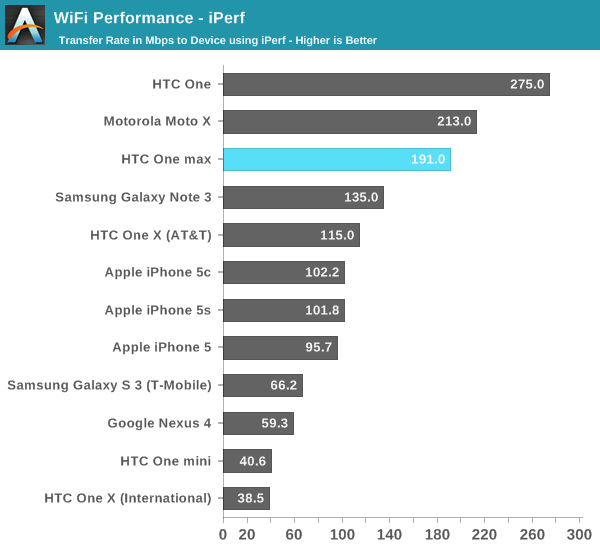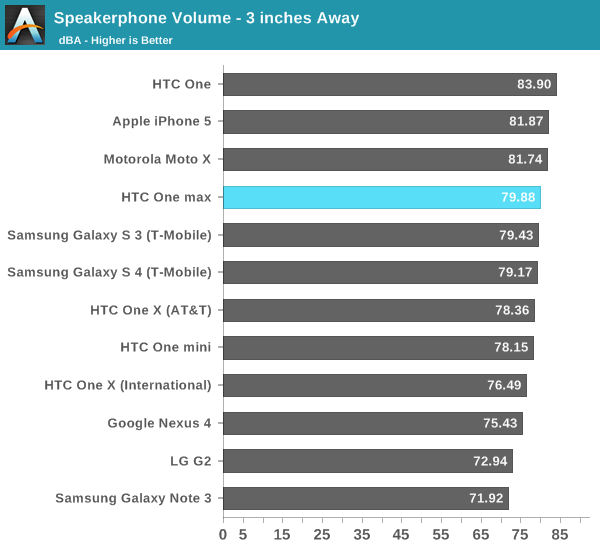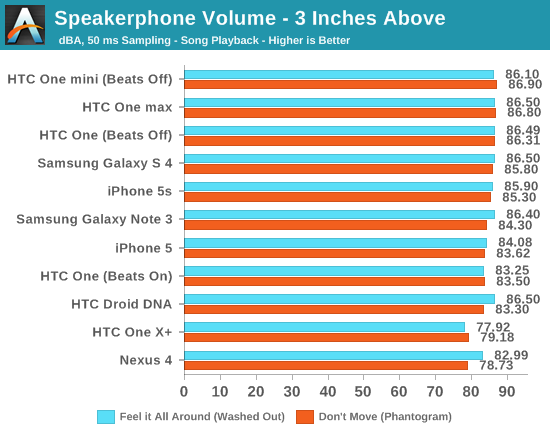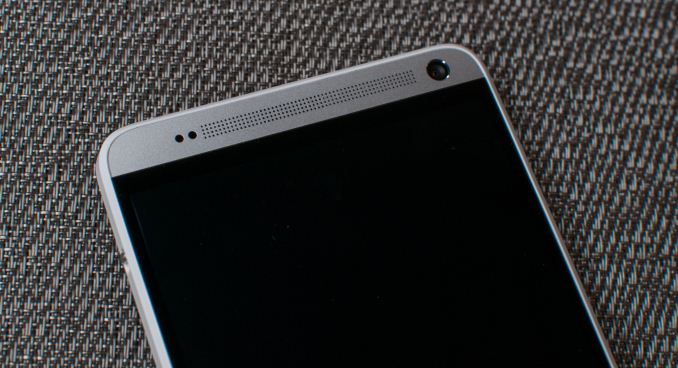HTC One max Review - It's Huge
by Brian Klug on October 28, 2013 10:00 AM EST- Posted in
- Smartphones
- HTC
- Mobile
- One
- Snapdragon 600
- Android 4.3
- One max
Cellular
Cellular on the One max is pretty much the same story as the One, and another shared bullet point. The top and bottom metal cutouts are still the radiative surfaces of the antenna, and there’s still transmit and receive diversity as well to mitigate any unwarranted antenna detuning from holding the device. The unit I was sampled has LTE banding for EMEA (Europe, Middle East, and Africa), but there’s appropriate banding for Asia, Sprint (a tri-mode device with 800/1900 MHz and TDD-LTE on 2600 MHz) and Verizon (700 MHz and AWS), according to the HTC specs page.
The baseband inside the One max is again shared with the One (Qualcomm’s 2nd generation multimode LTE MDM9x15 family), although the One max does have a bit more band support for the USA LTE on Sprint and Verizon, so the front ends are different.
WiFi
Interestingly enough with the One max we see HTC going to Qualcomm Atheros for the WLAN and BT combo, best I can tell this is the WCN3680 which is probably a bit cheaper to include than the BCM4335 we saw in the One. It’s still a single spatial stream 802.11ac capable part, meaning a PHY rate of up to 433 Mbps if you’re in the right channel conditions with 80 MHz channels on 5 GHz. The WCN3680 combo is the 802.11ac successor to WCN3660 which we saw in a number of phones last generation, and is accelerated by the SoC. WCN3680 also does BT 4.0, and FM Rx/Tx if applicable.

To test throughput on the One max I used iPerf the same way I have for a while now. Subjectively there are no complaints from me about WLAN connectivity on the One max, no random dropouts or issues, and Sense 5.5 thankfully still includes the WiFi frequency band manual selection option.
I saw the WCN3680 solution inside Moto X already, it’s interesting to see it in the One max. I believe the One mini uses its 802.11n cousin, WCN3660 as well, probably again for cost reasons.
Speakerphone
Although Beats is gone since that partnership has ended as of the One max, the device still seems to retain everything that made it sound great. There are still the larger-than-typical speaker chambers, big speaker grilles on the top and bottom, stereo sound, and importantly the TFA9887 speaker amplifier and protection part from NXP. In addition there’s still the TPA6185 headphone amplifier as well.
Beats always seemed to be an audio compressor that ran on the DSP, ostensibly through the Hexagon DSP access program or something, and that’s what’s absent on the One max. There’s no toggle under settings for enabling or disabling it, nor the Beats branding, but to be honest I almost always disabled Beats on the One anyways since it was a fair amount louder with it disabled. What made the One great was all the hardware behind the speakers, not so much the software compressor.


The One max goes plenty loud just like the original One. I went ahead and added the One mini and 5s to the chart too, just to check whether things have changed much, in addition to the Galaxy S 4 and Note 3. The One max basically performs like the One with Beats turned off, which isn’t a surprise since it isn’t there anymore. There’s also no detectable saturation, and the One line remains the only device that doesn’t sound tinny or rattly with overemphasized highs and lacking mids. I suspect the A weighting I selected a while ago for measuring might be a contributing factor as well. Either way you’re not going to be wanting for more loudness on the One max, and the inclusion of front firing stereo speakers makes for a completely different listening experience.












197 Comments
View All Comments
chizow - Tuesday, October 29, 2013 - link
Couldn't have written it better myself, I'll be honest and say I haven't read through an entire one of Brian Klug's reviews but if they were all filled with this kind of distorted reality transposed to the general populous, I probably wasn't missing much.Simply put, microSD opens up uses that base model 16GB phone users could never dream of using for their phones. For example, I recently had 2 large family events during the same weekend, took multiple movies at full 1080p on my SGS4 with a UHS-I microSD and captured around 25GB of footage. Never could I have done this with my 16GB Apple 4S, nor would I even attempted to do it.
And what would the other option be? Pay 2x as much for 16GB more? No thanks, not when I can just move my microSD card from one phone to the next and not get fleeced on extra storage every time I buy a new device, with my own money (seems to be a key point lost upon Brian, anyways).
seapeople - Tuesday, November 5, 2013 - link
So let's see... I'm a budget conscious consumer who is shopping for a smartphone that I'm going to keep for 4 years because I'm too cheap to upgrade sooner. My options are 16GB phone + microSD card for a total four year price of $3600, or a 64GB phone with faster native storage for a total four year price of $3760.Can't you see why it's absolutely ridiculous how you microSD shills freak out over such a pointless little feature? Just buy the overpriced flash storage and forget about it, it's barely a bump in the road for someone who's paying for a smart phone data plan anyway.
Spunjji - Thursday, November 28, 2013 - link
Nice work, that straw man was totally asking for it and boy did you give it to him. You're such a big man.tipoo - Monday, October 28, 2013 - link
I do like the cheating table of shame there, but I also worry that this would just make the cheating more sophisticated, with phones being able to detect apps even with renames and hide their clock speeds etc.FalcomPSX - Monday, October 28, 2013 - link
just how big are phones going to get before people realize how absolute ridiculous it looks holding a tablet sized device up to your ear? Something the size of the original htc one is just about right.AssBall - Monday, October 28, 2013 - link
Its more ridiculous watching someone hold a tiny phone 8 inches from their face so they can see what it says and push the tiny buttons. I'll take a larger phone any day. Easier to use, harder to lose, good battery, nice screen size.MikePCUser - Monday, October 28, 2013 - link
Comparison videos between the One Max and the One on YouTube also show the MICROPHONE is decidedly inferior on the One Max. I wish you had tested that as well!chizow - Monday, October 28, 2013 - link
Brian, while you are certainly entitled to your opinion of every aspect of the smartphone market, I think you need to take a step back and realize not everyone is in your situation and receives free phones for review or a product budget for AT to buy review samples.I think your comments with regard to SD cards in particular are off target, as it is an important feature for many users who do not want to pay exorbitant amounts for miniscule increments of storage. 128GB models if some popular phones like the iPhone 5S literally double the on-contract price vs a 64GB SD card that sells for 50 bucks.
Contrary to what you have said, the fact the One Max's inclusion of an SD slot along with myriad other Android and Windows tabs and phones illustrates SD slots are NOT going the way of the dodo. Hopefully companies do not take your opinions on the matter as fact.
Brian Klug - Monday, October 28, 2013 - link
Please read my above comments about SD cards, the reality is that the demographic that uses them is a lot smaller than you'd think.Also there's no 128 GB iPhone 5S, just 64 GB.
The context everyone is missing is that I would not trade an SD card slot for the removable door and build quality tradeoffs it brings.
-Brian
10101010 - Monday, October 28, 2013 - link
What you present regarding SD cards and build quality tradeoffs is largely a false dichotomy based on your own biases regarding particular aspects of "build quality".Take for example, the Sony Xperia Z Ultra. It's about the same size as the One Max and offers SD card expansion. Many reviewers have positively commented on the build quality of this device, even noted that it offers water and dust resistance. A more insightful reviewer would realize that it isn't the SD card that is responsible the particular issues you have with build quality, it is the fact that the phone wasn't designed well to begin with.
Of course, you would probably still disparage all the purchasers of this device for wanting flexible affordable local storage and find some way to disparage the device for poor build quality anyway. After all, biasing people away from flexible and cheap local storage and towards expensive and easily data-mined in-cloud storage is what your corporate masters want, isn't it?
If we look at your shallow view of "build quality", then it becomes even more obvious that there is a false dichotomy. You don't spend much time balancing how easy it is to repair a device vs. how it is built. You don't balance the fact that many phones with removable back covers have replaceable batteries. Nor do you balance the additional radiation going into someone's head because a phone is made of metal. Essentially, you are looking at a few aspects of something that resonate with your biases and proclaiming some judgment that SD cards are bad for phones and that the people who want SD cards are some sort of small, unimportant, and obnoxious minority.
Even if you continue to push your biases in your "reviews", maybe it's time for a bit more honesty? You can still write a good review if you say "I just don't like SD cards because it's hard for me to manage removable local storage".